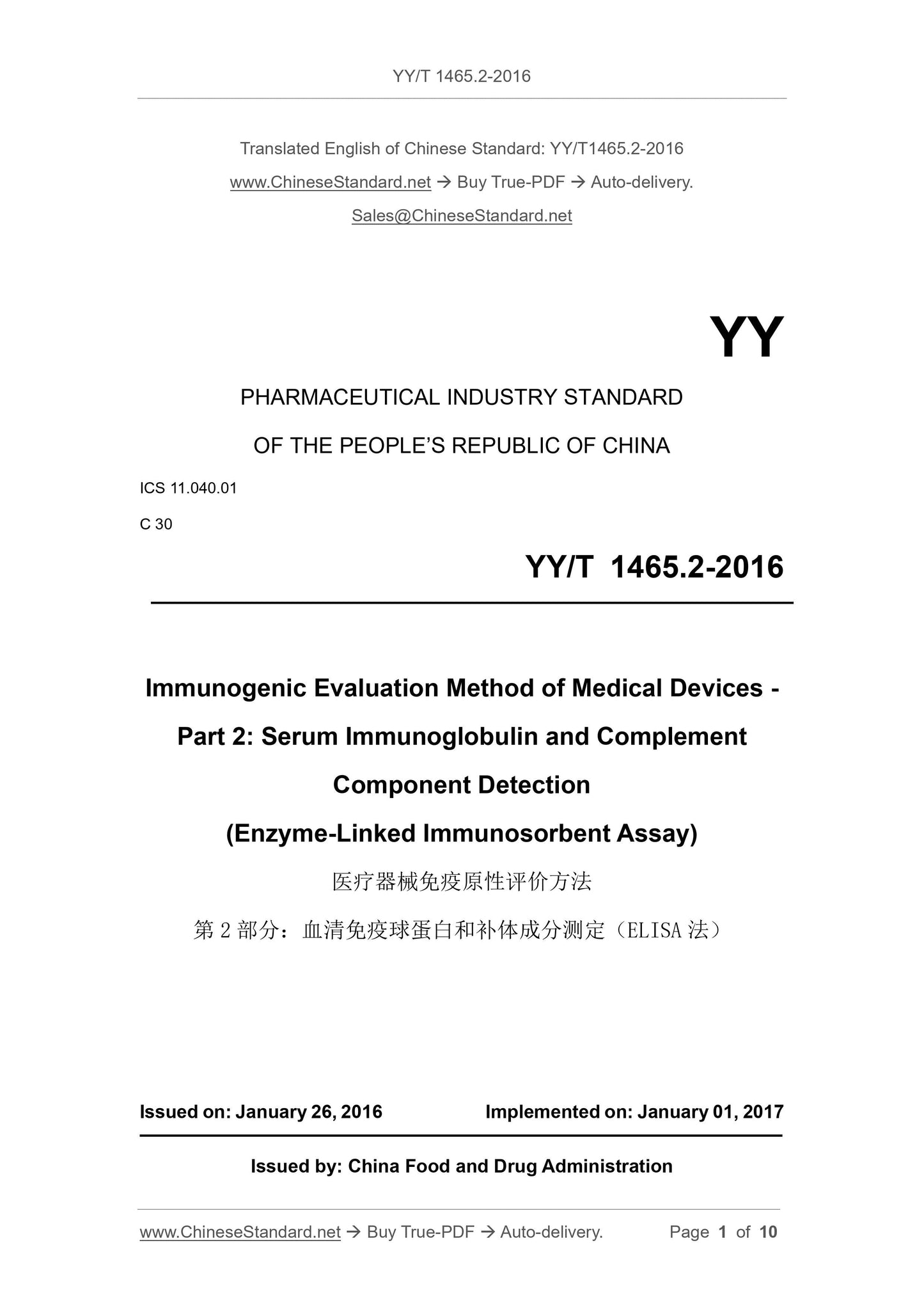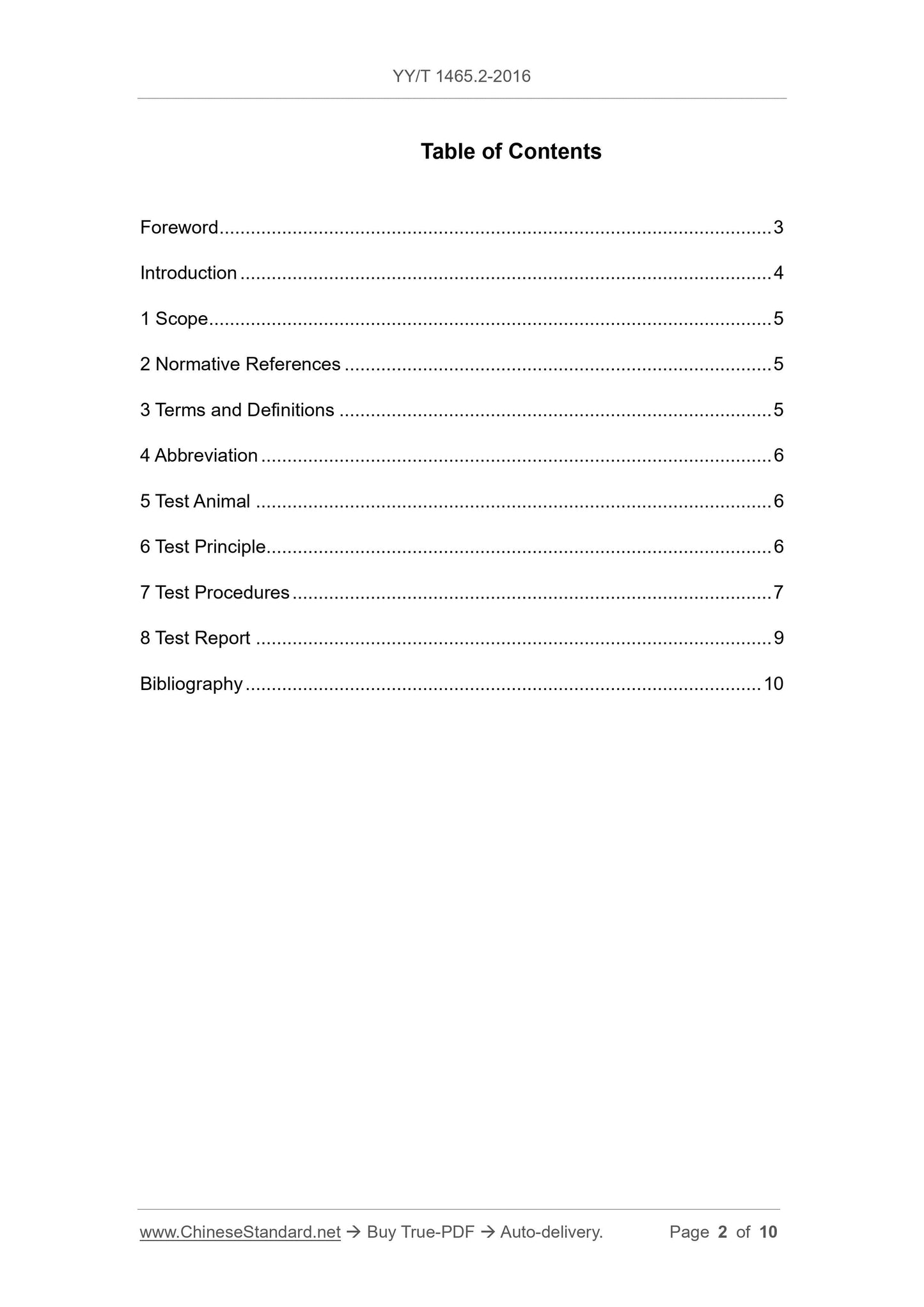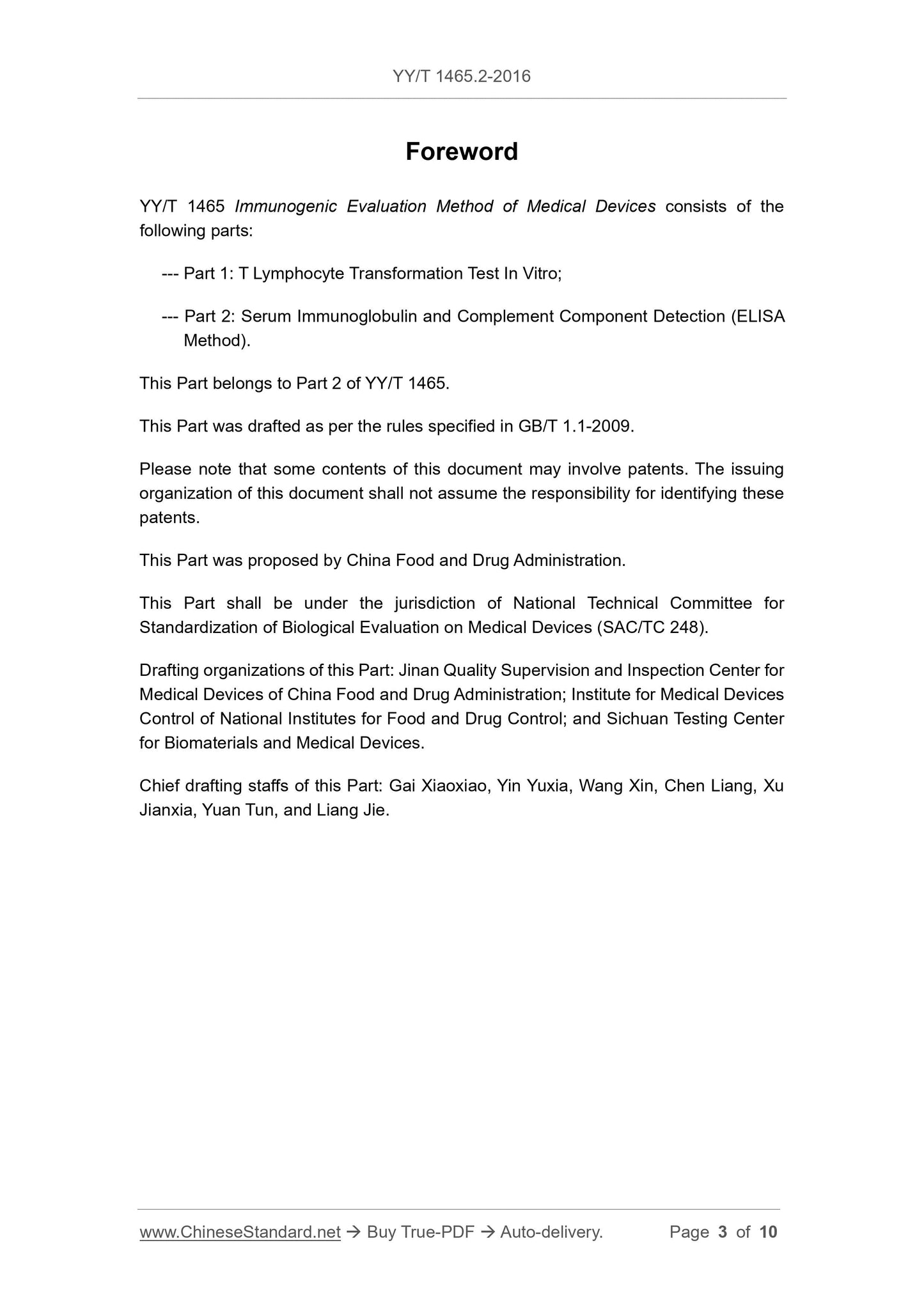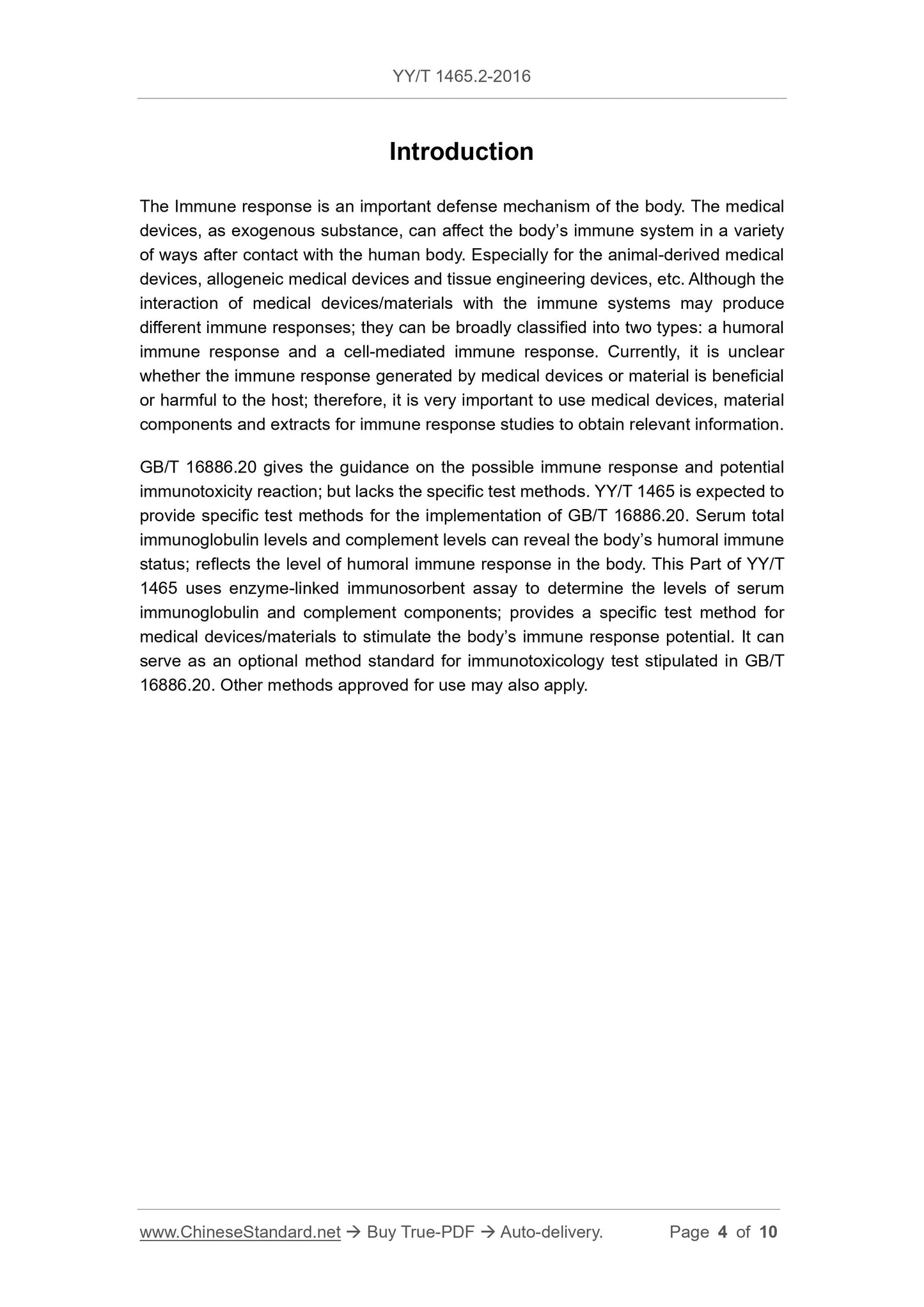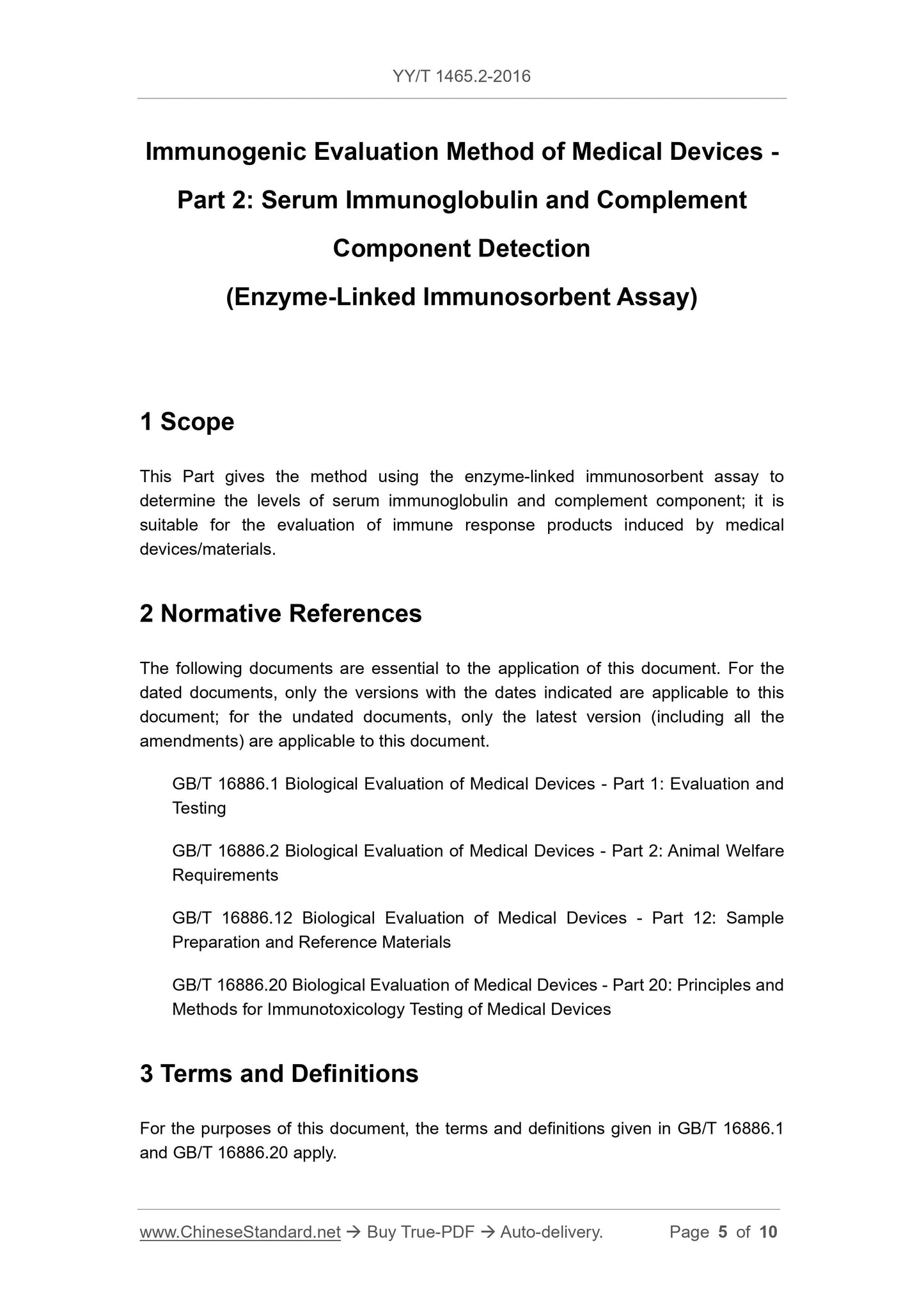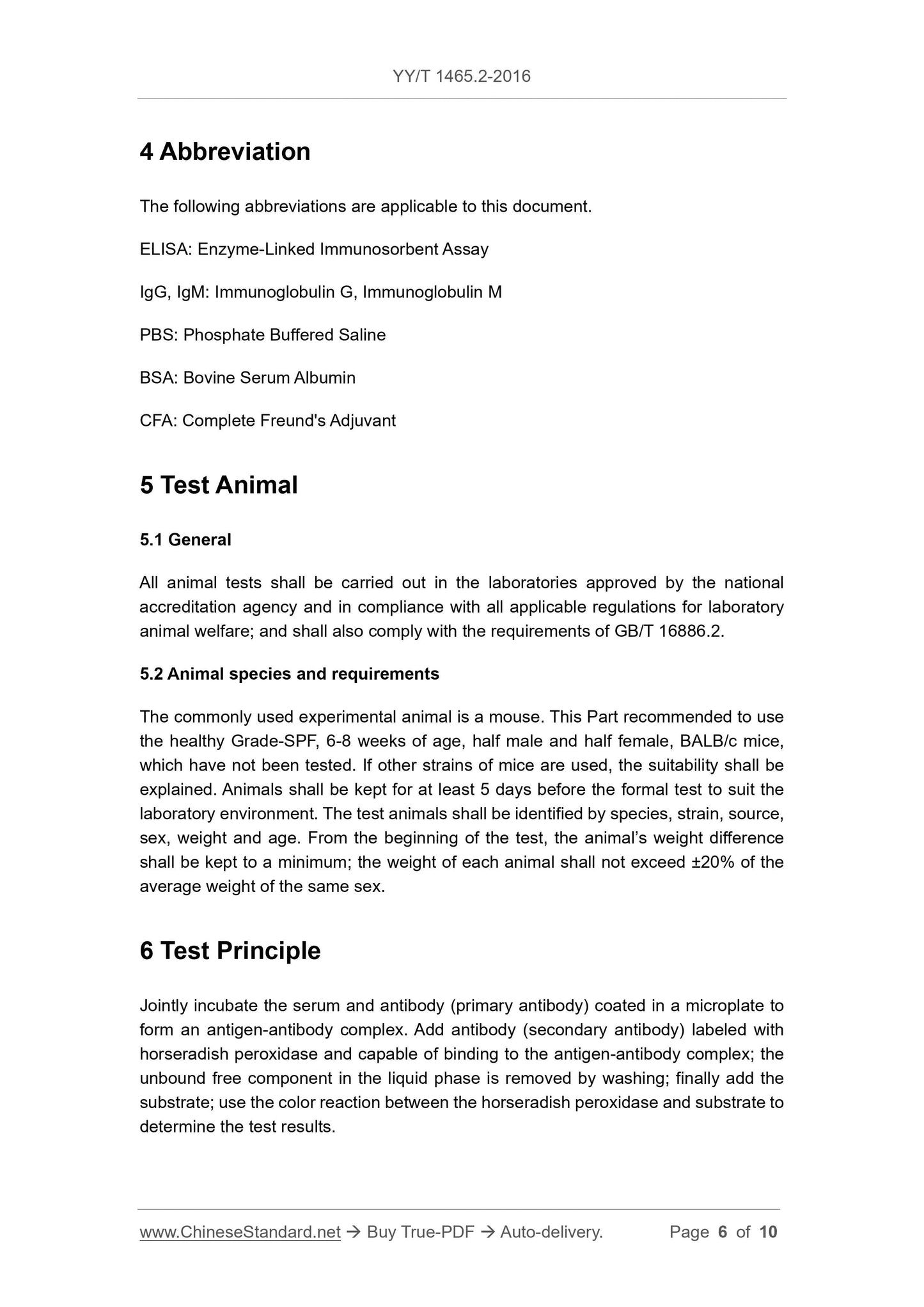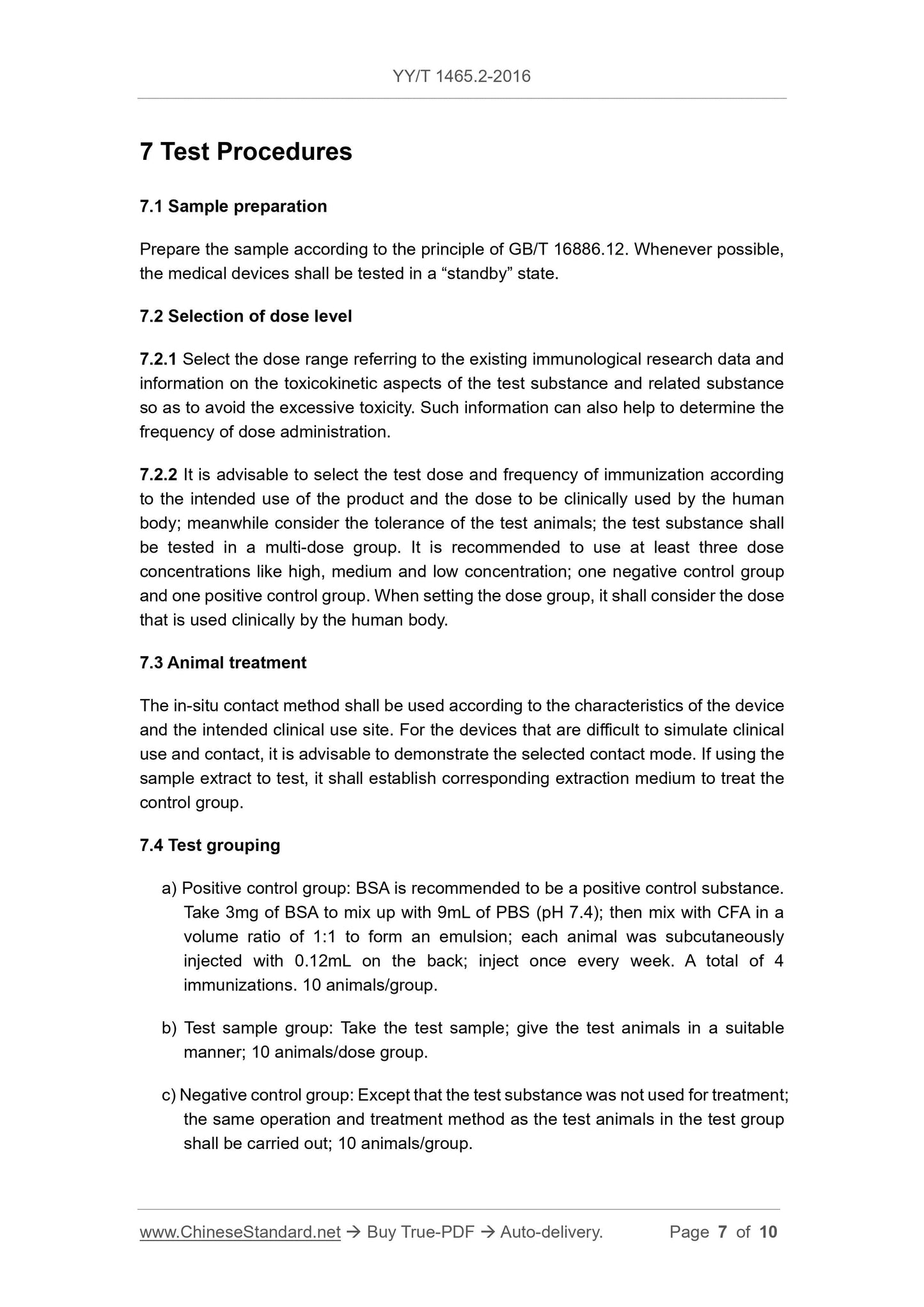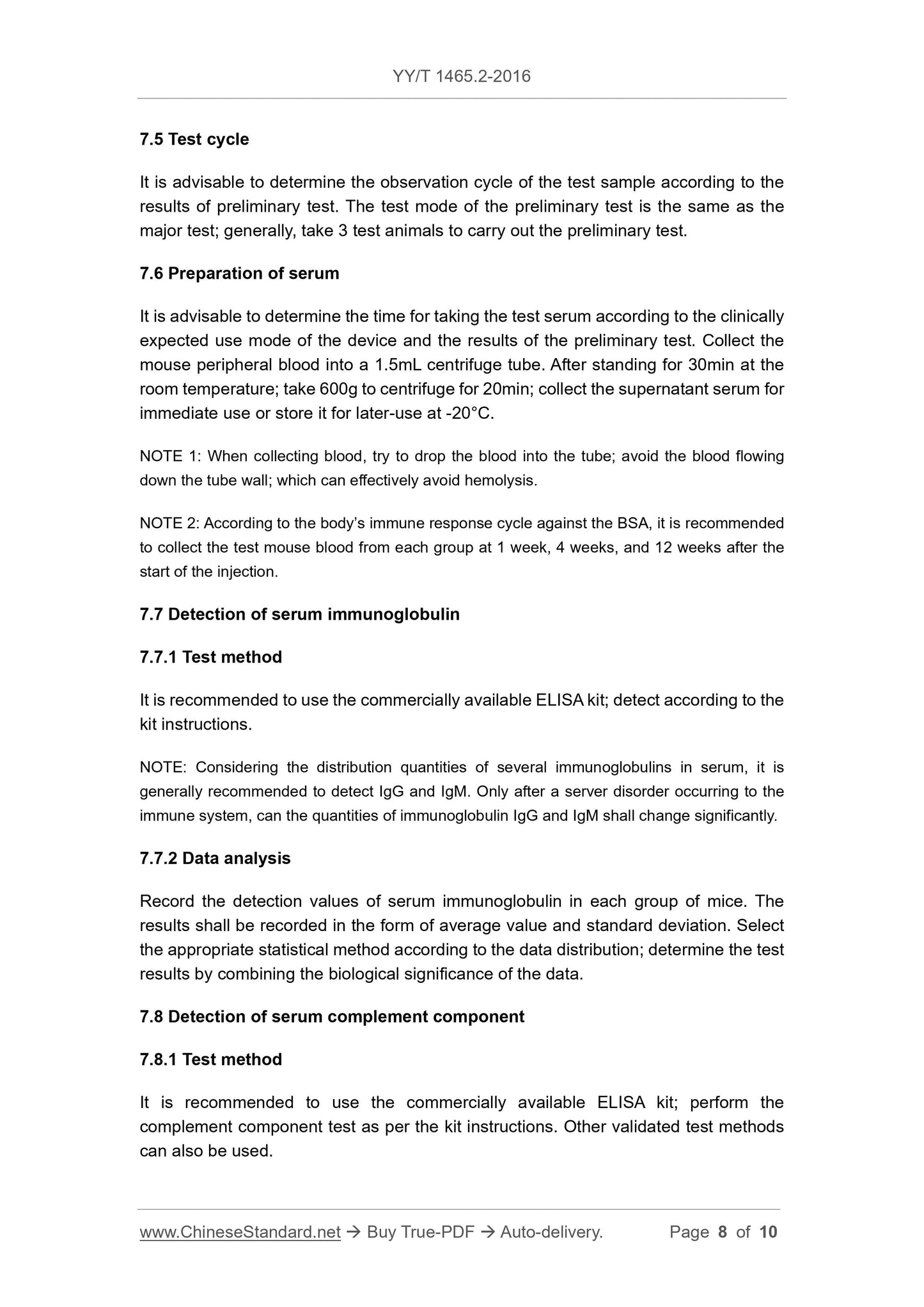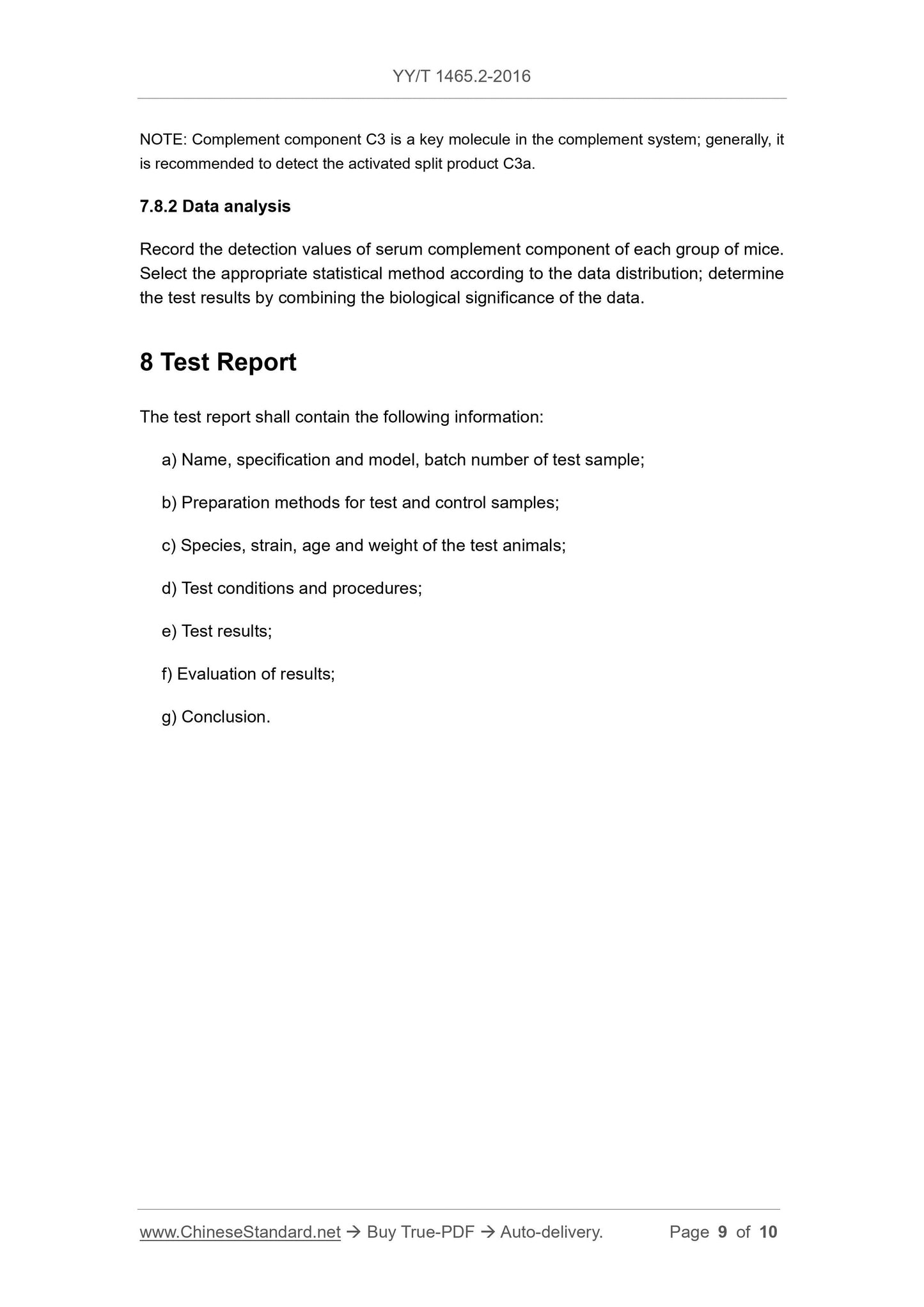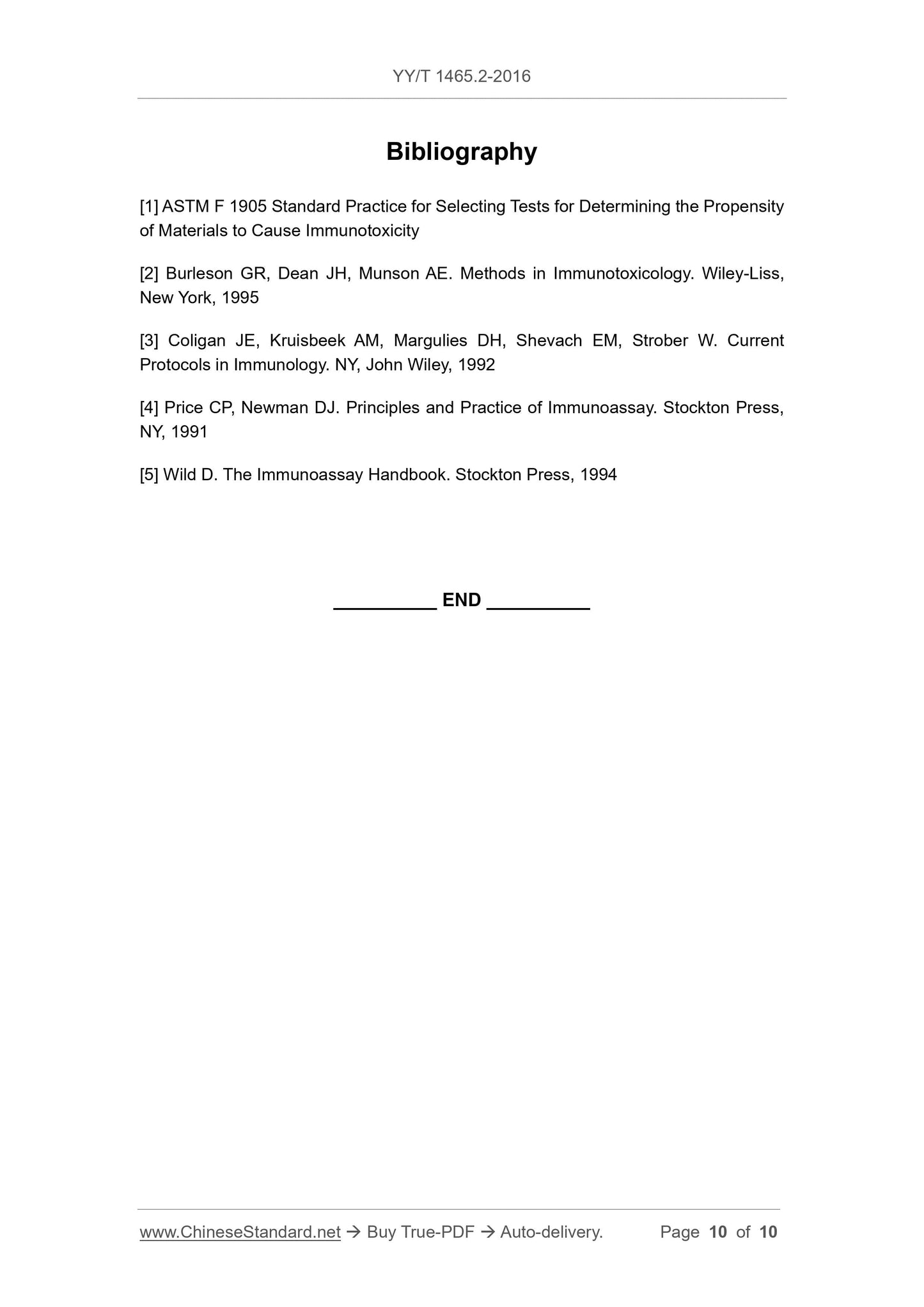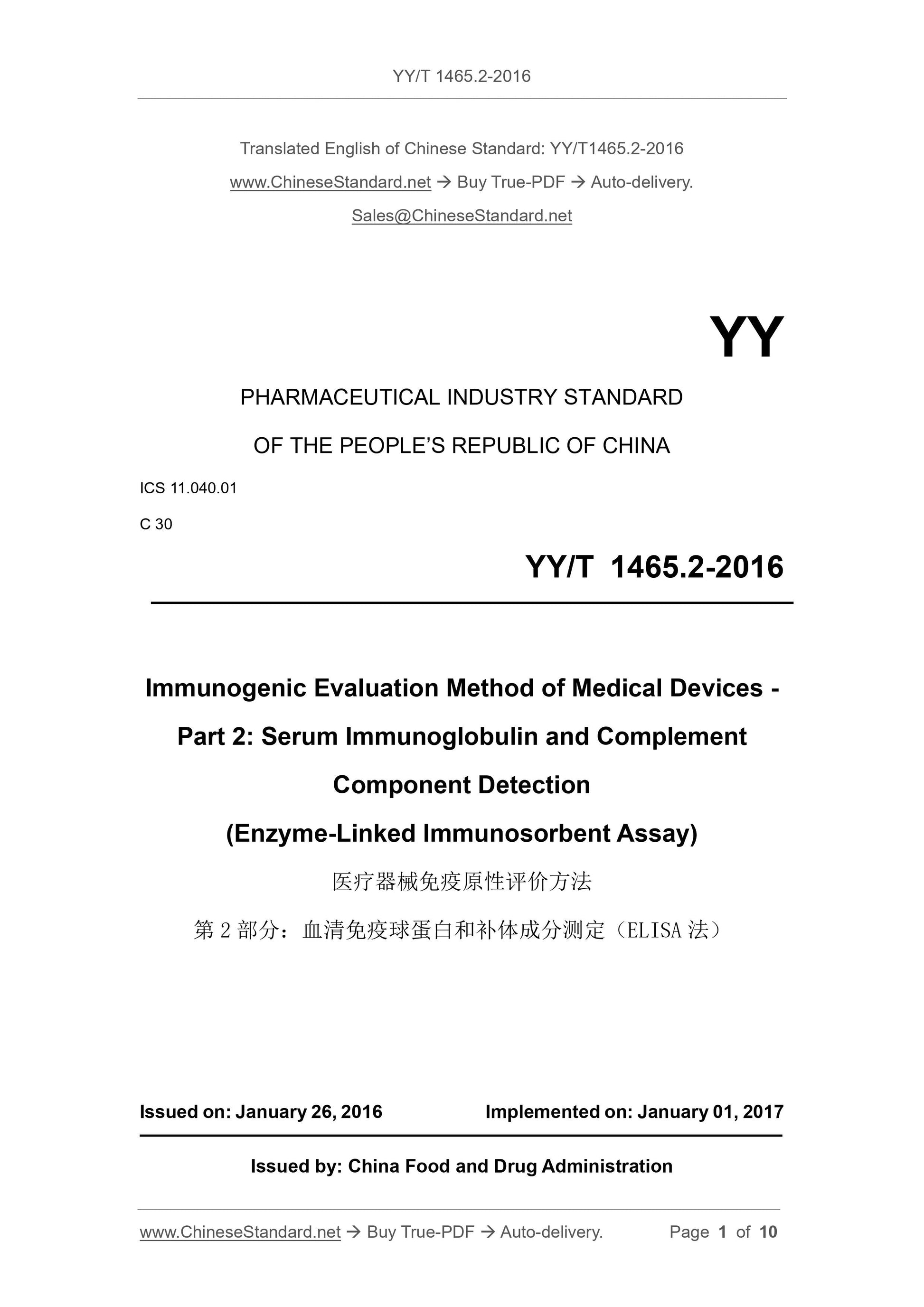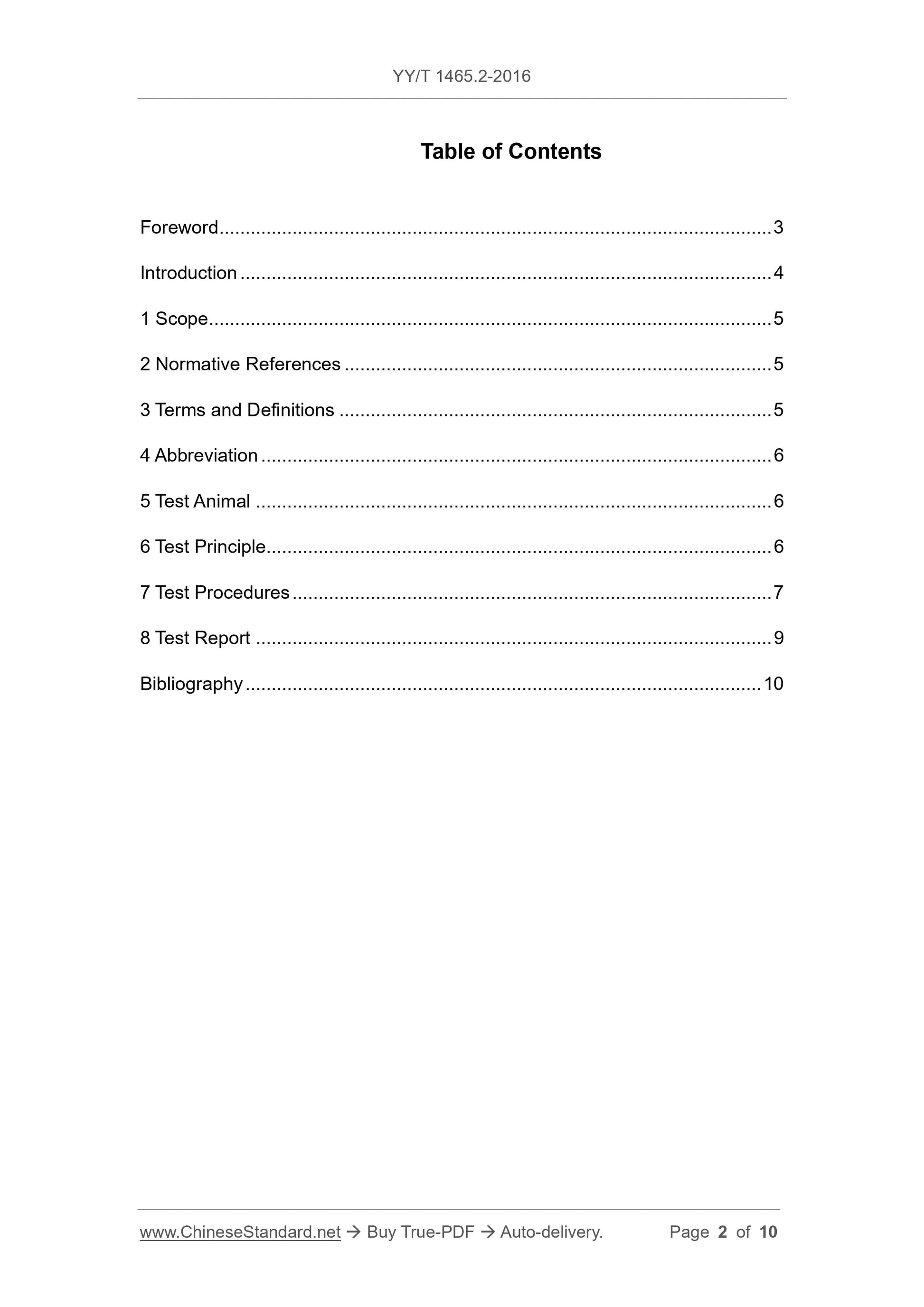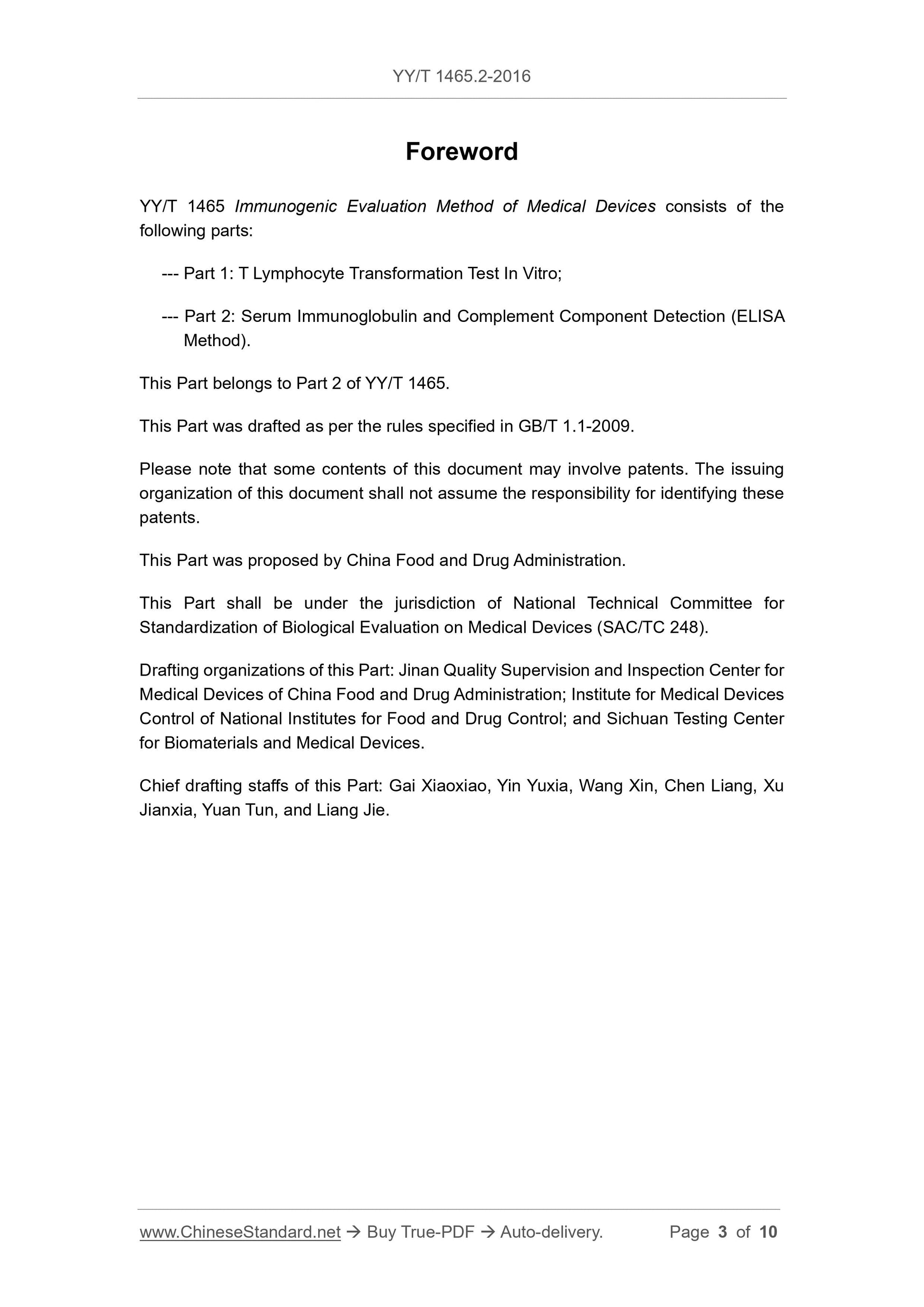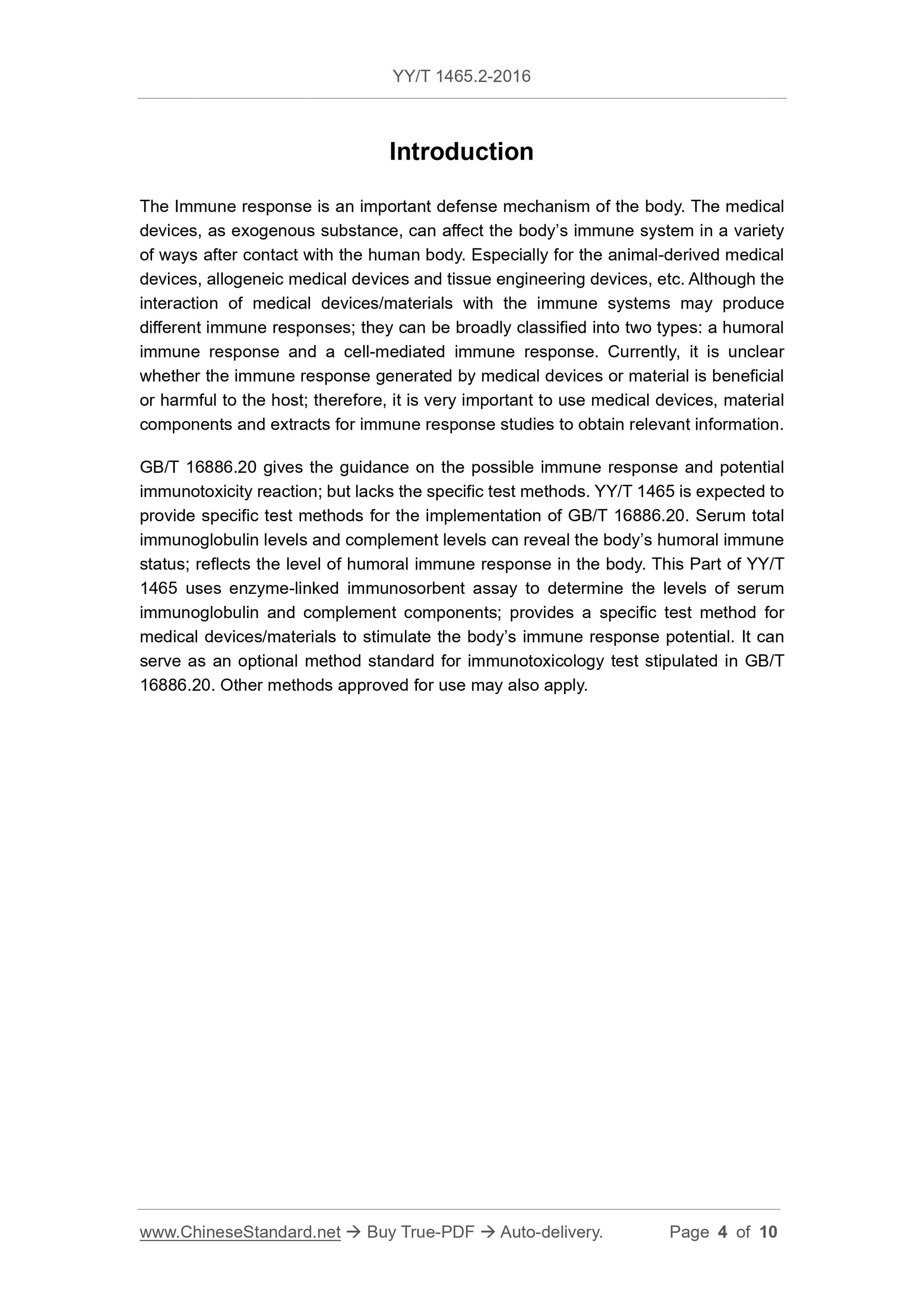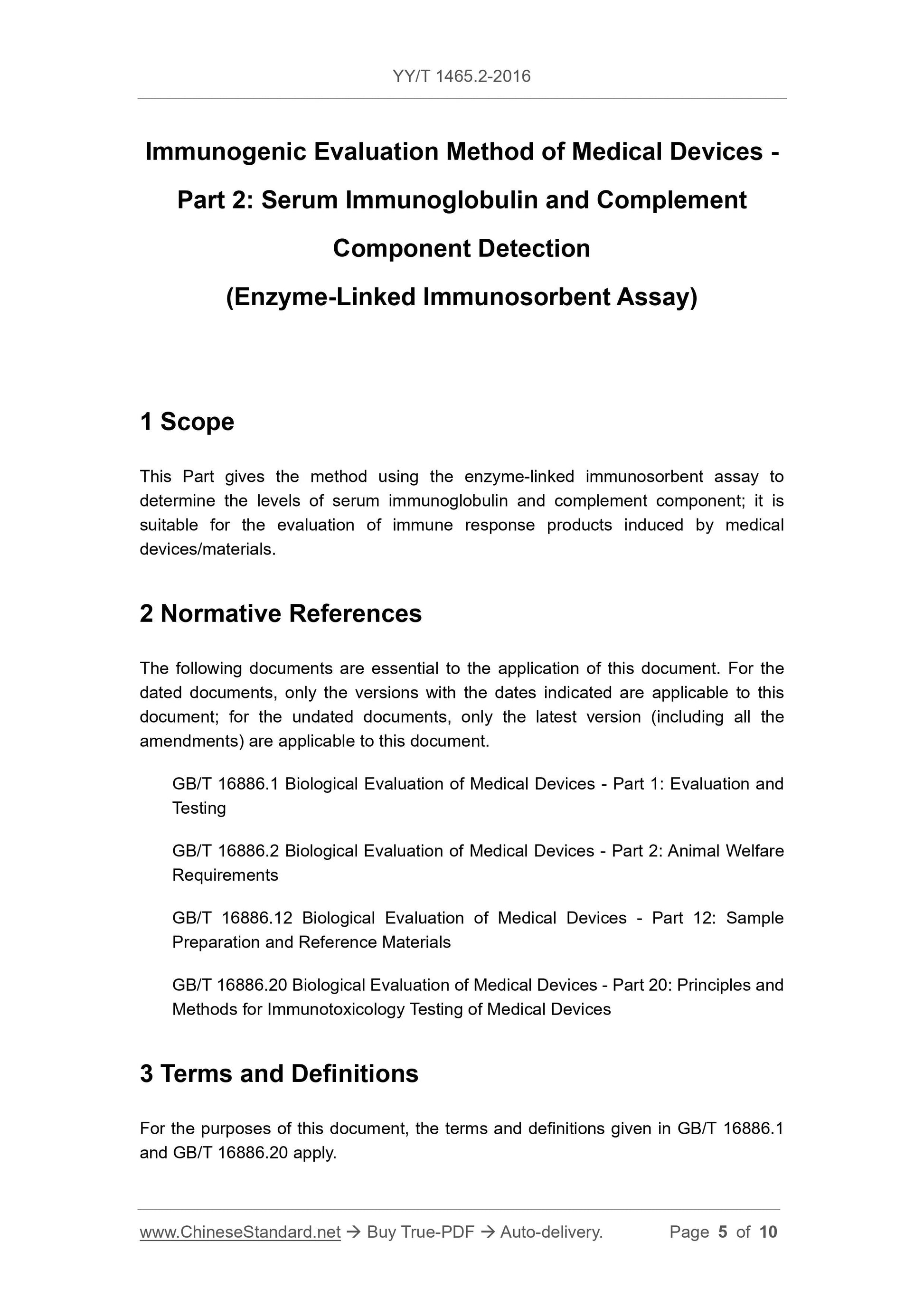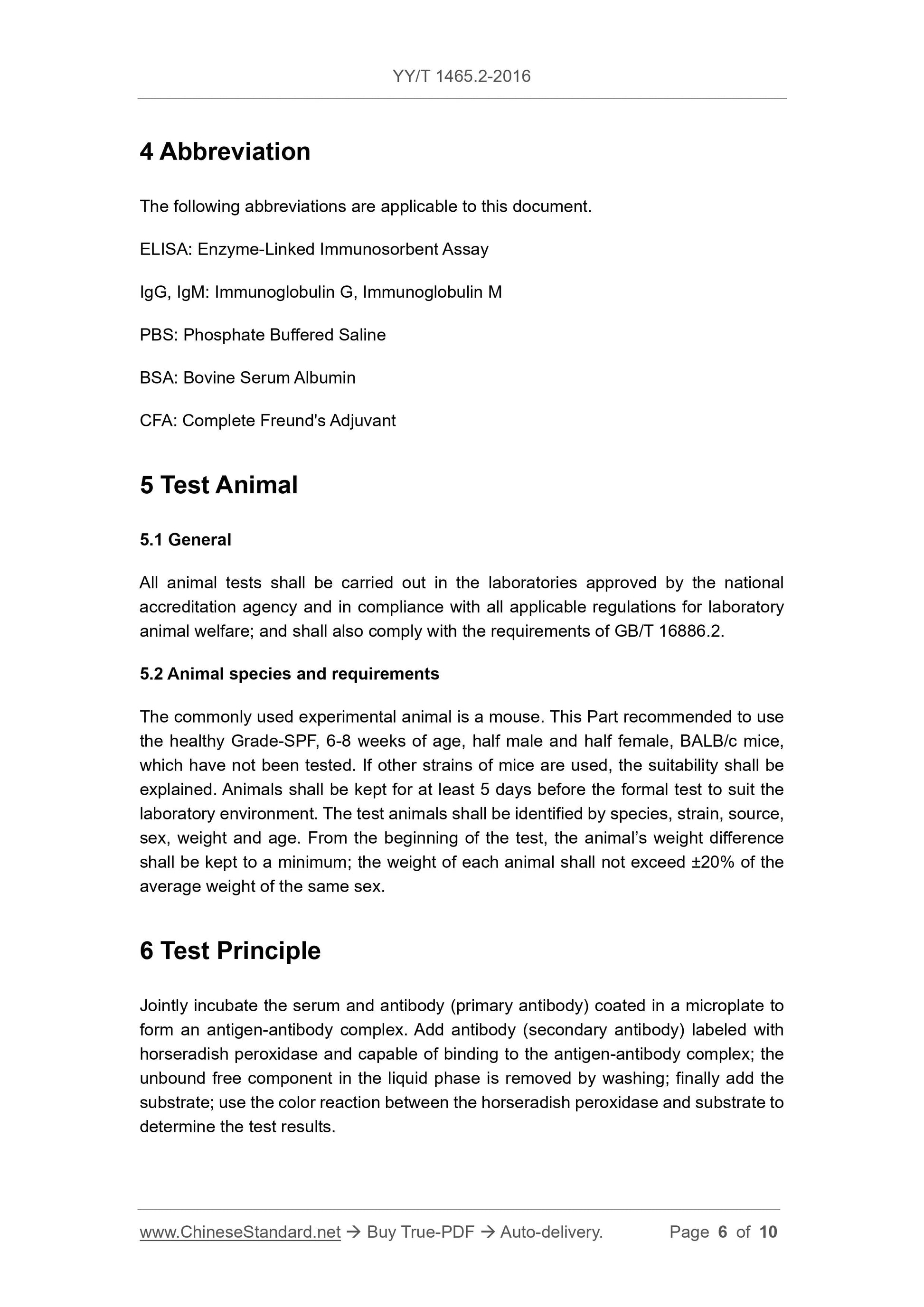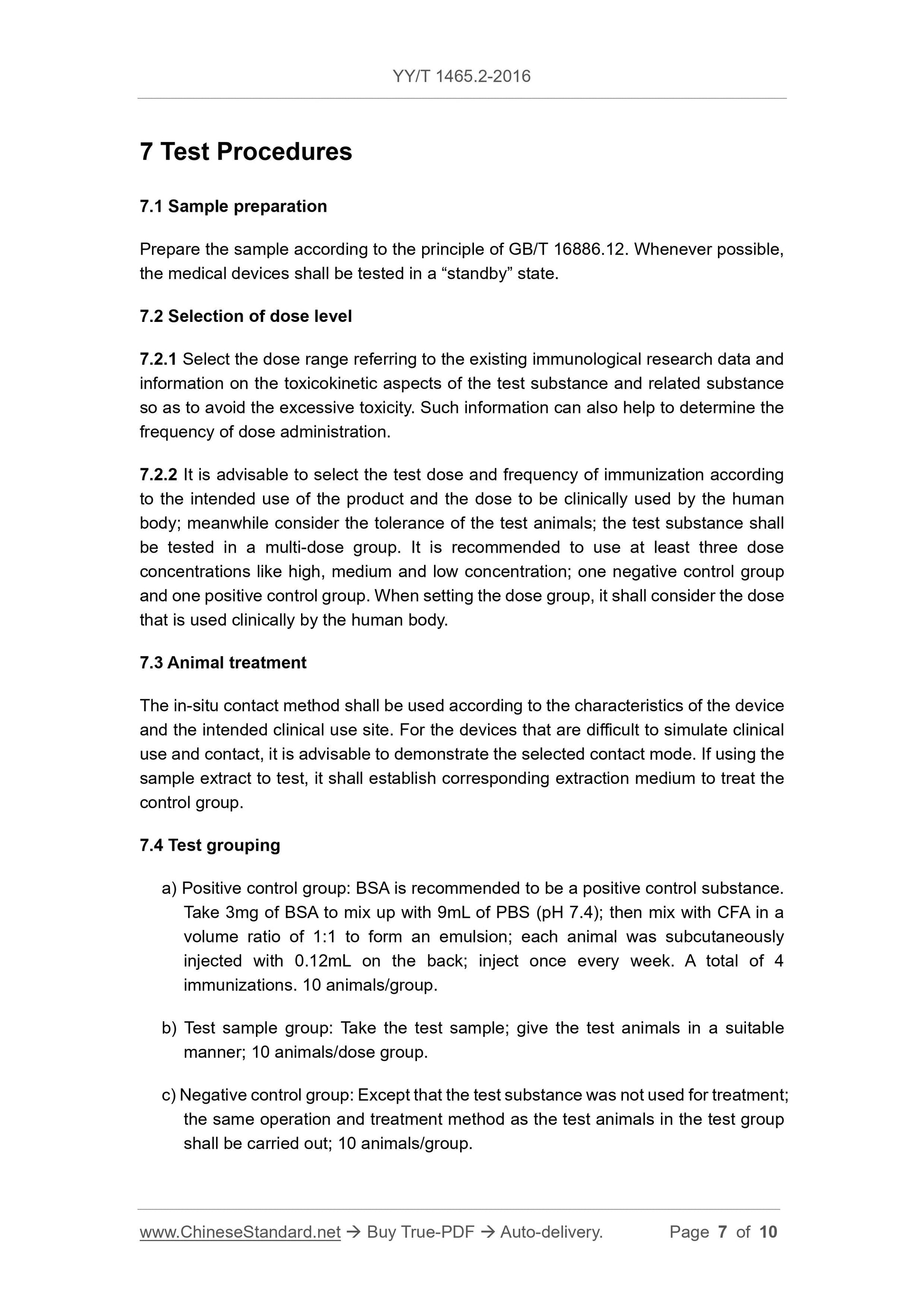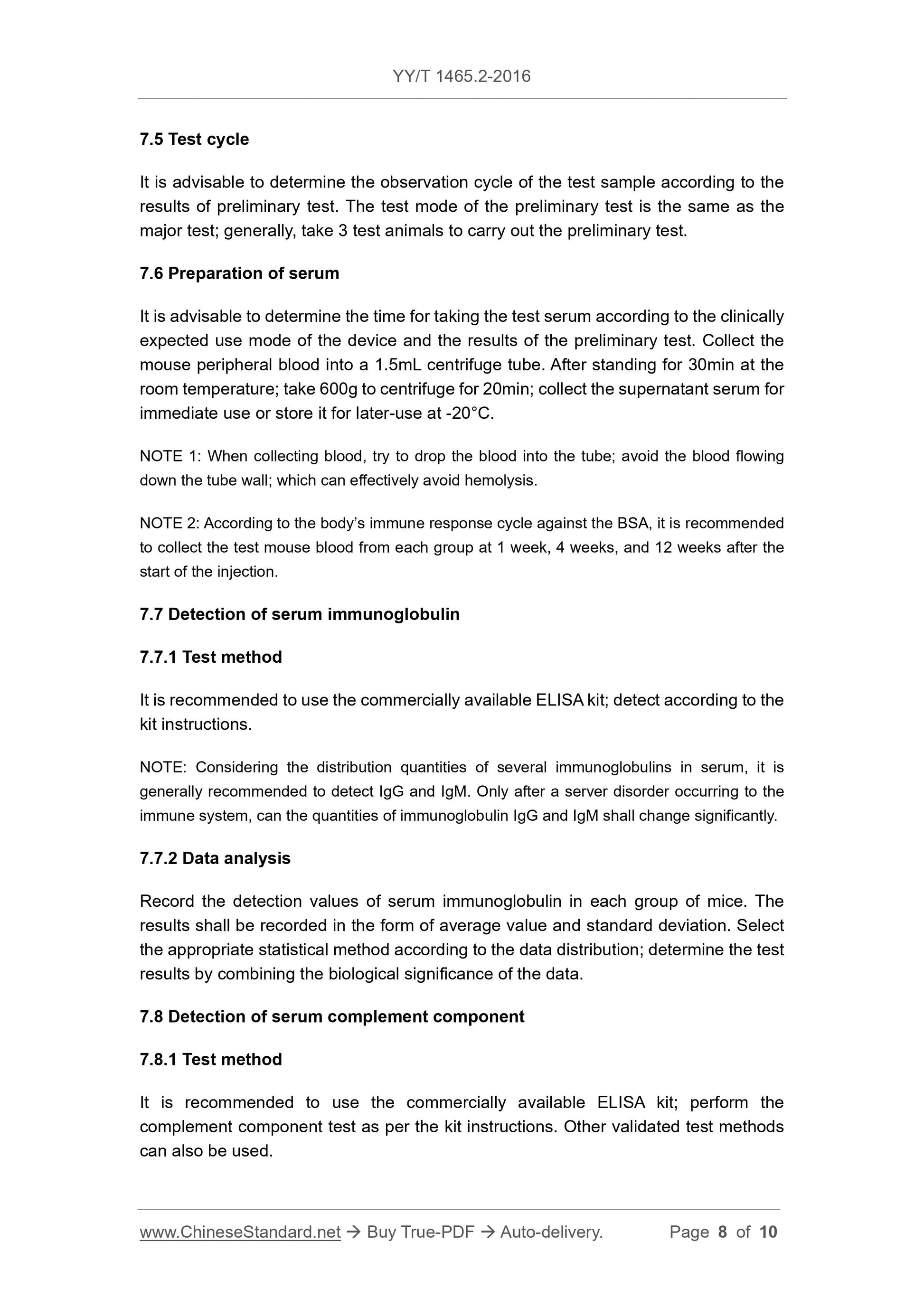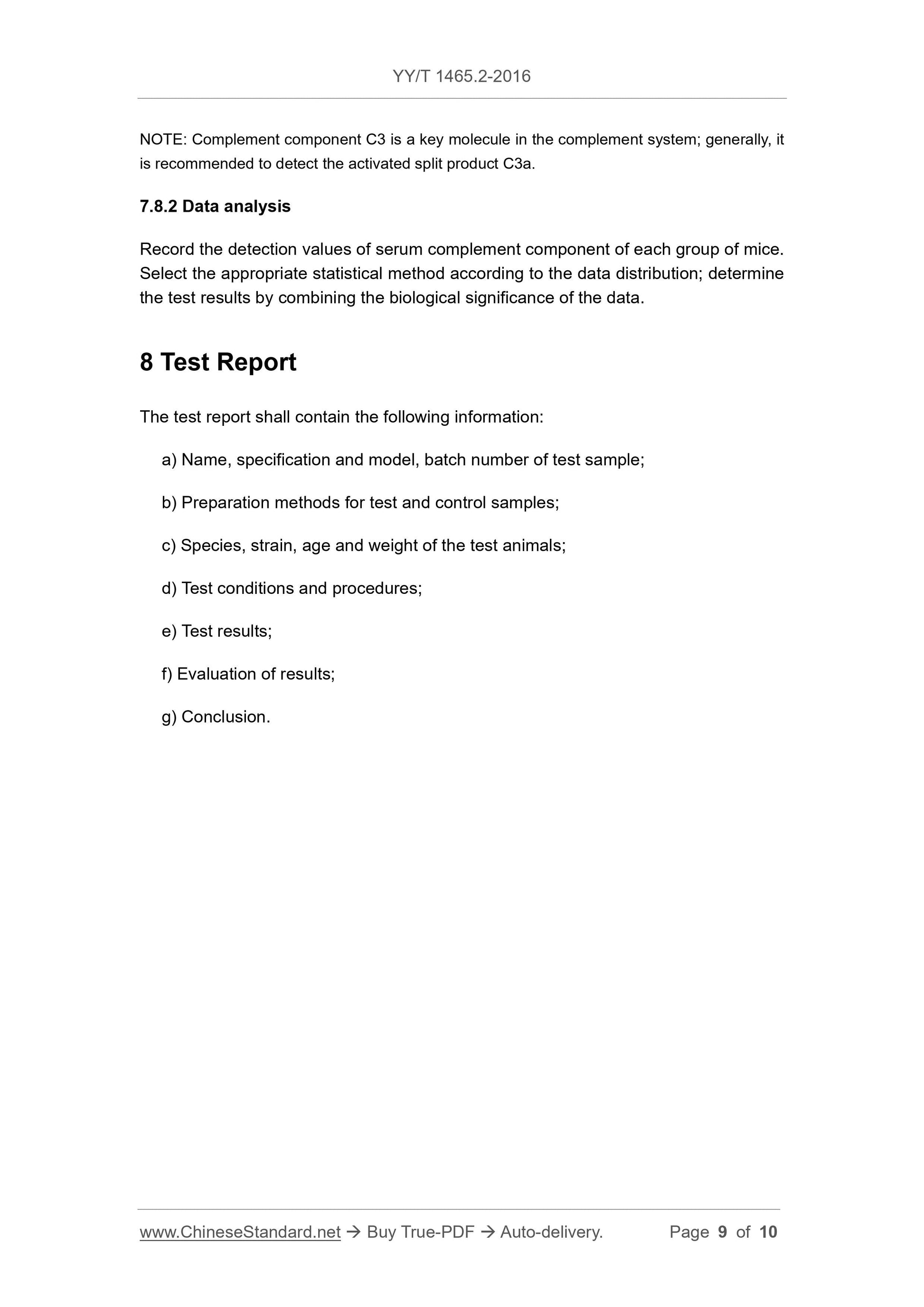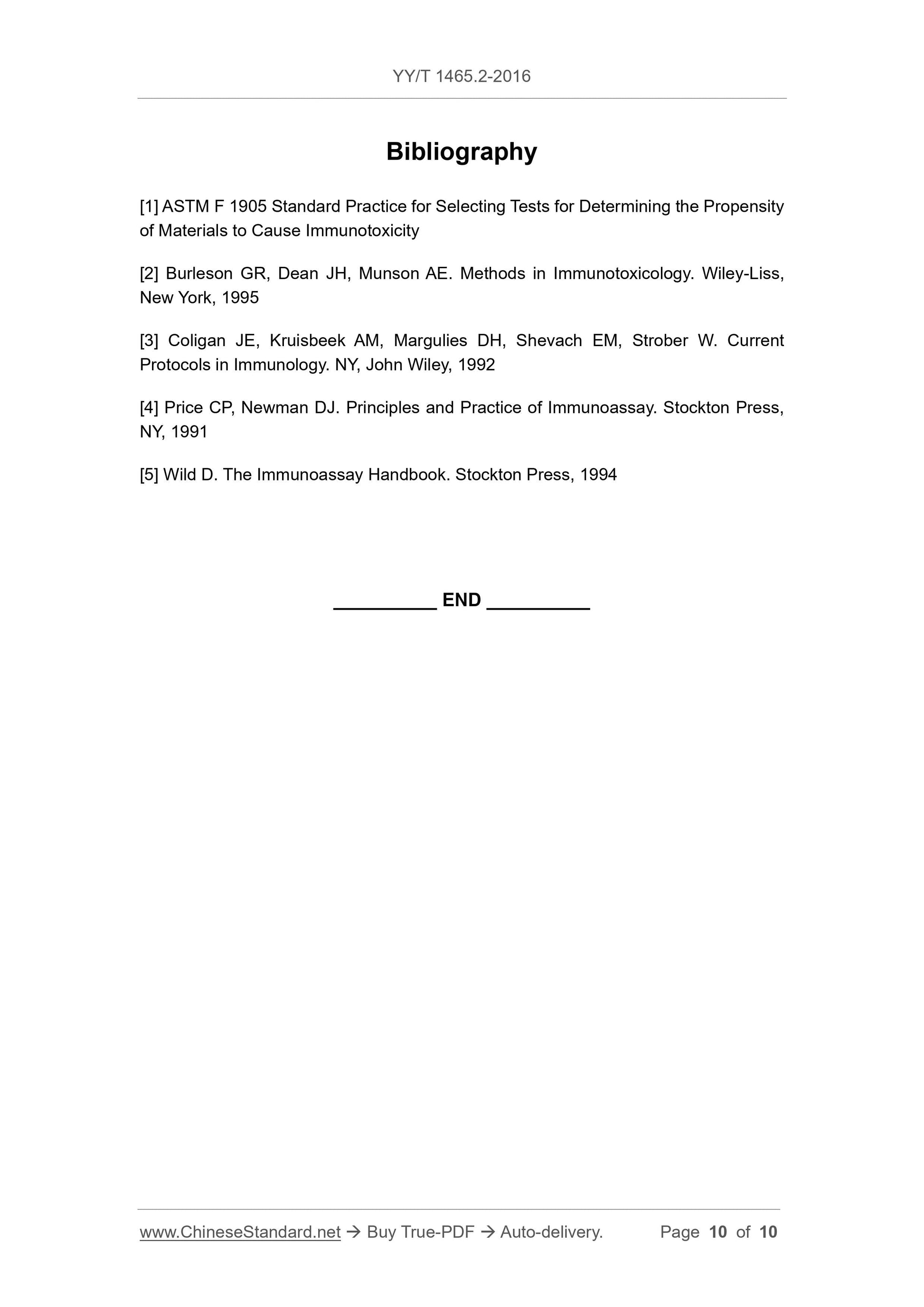1
/
of
10
PayPal, credit cards. Download editable-PDF & invoice in 1 second!
YY/T 1465.2-2016 English PDF (YY/T1465.2-2016)
YY/T 1465.2-2016 English PDF (YY/T1465.2-2016)
Regular price
$120.00 USD
Regular price
Sale price
$120.00 USD
Unit price
/
per
Shipping calculated at checkout.
Couldn't load pickup availability
Delivery: 3 seconds. Download true-PDF + Invoice.
Get Quotation: Click YY/T 1465.2-2016 (Self-service in 1-minute)
Historical versions (Master-website): YY/T 1465.2-2016
Preview True-PDF (Reload/Scroll-down if blank)
YY/T 1465.2-2016: Immunogenic Evaluation Method of Medical Devices - Part 2: Serum Immunoglobulin and Complement Component Detection (Enzyme-Linked Immunosorbent Assay)
YY/T 1465.2-2016
Immunogenic evaluation method of medical devices. Part 2. Serum immunoglobulin and complement component detection (enzyme-linked immunoadsorbent assay)
ICS 11.040.01
C30
People's Republic of China Pharmaceutical Industry Standard
Medical device immunogenicity evaluation method
Part 2. Serum immunoglobulins and complements
Component determination (ELISA method)
Part 2. Serumimmunoglobulinandcomplementcomponentdetection
Published on.2016-01-26
2017-01-01 implementation
State Food and Drug Administration issued
Foreword
YY/T 1465 "Method for Evaluating Immunogenicity of Medical Devices" is divided into two parts.
--- Part 1. In vitro T lymphocyte transformation test;
--- Part 2. Determination of serum immunoglobulin and complement components (ELISA method).
This part is the second part of YY/T 1465.
This part is drafted in accordance with the rules given in GB/T 1.1-2009.
Please note that some of the contents of this document may involve patents. The issuing organization of this document is not responsible for identifying these patents.
This part is proposed by the State Food and Drug Administration.
This part is under the jurisdiction of the National Technical Committee for Standardization of Medical Device Biology Evaluation (SAC/TC248).
This section drafted by. State Food and Drug Administration, Jinan Medical Device Quality Supervision and Inspection Center, China Food and Drug Administration
Institute of Medical Devices, Sichuan Medical Device Biomaterials and Products Inspection Center.
Drafters of this section. Gai, Yin Yuxia, Wang Wei, Chen Liang, Xu Jianxia, Yuan Wei, Liang Jie.
introduction
The immune response is an important defense mechanism of the body. As an exogenous substance, medical devices pass through various ways after contact with the human body.
The path affects the immune response of the body's immune system. Especially for animal-derived medical products, allogeneic products and tissue engineering medical products
Wait. Although the interaction of medical devices/materials with the immune system may produce different immune responses, they can be broadly classified into two types.
That is, humoral immune response and cell-mediated immune response. At present, it is not possible to determine the immune response to the host caused by medical devices or materials.
It is beneficial or harmful, so it is very important to apply medical devices/materials for immune response research to obtain relevant information.
Guidance on the possible immune response and potential immunotoxicity of medical devices in contact with humans is given in GB/T 16886.20.
However, there is a lack of specific test methods. The YY/T 1465 series of standards is expected to provide specific test methods for the implementation of GB/T 16886.20.
Serum total immunoglobulin levels and complement levels can reveal the body's humoral immune status, reflecting the level of humoral immune response in the body.
In this part of YY/T 1465, the levels of serum immunoglobulin and complement components were determined by enzyme-linked immunosorbent assay (ELISA).
The ability of the device/material to stimulate the body's immune response provides a specific test method. Can be used as an immunotoxicology test in GB/T 16886.20
An alternative method standard. Other methods approved for use may also be employed.
Medical device immunogenicity evaluation method
Part 2. Serum immunoglobulins and complements
Component determination (ELISA method)
1 Scope
This section gives a method for the determination of serum immunoglobulin and complement components by enzyme-linked immunosorbent assay, which is suitable for medical devices/materials.
Evaluation of the immune response product induced by the feed.
2 Normative references
The following documents are indispensable for the application of this document. For dated references, only the dated version applies to this article.
Pieces. For undated references, the latest edition (including all amendments) applies to this document.
GB/T 16886.1 Biological evaluation of medical devices - Part 1. Evaluation and testing in the process of risk management
GB/T 16886.2 Biological evaluation of medical devices - Part 2. Animal welfare requirements
GB/T 16886.12 Biological evaluation of medical devices - Part 12. Sample preparation and reference samples
GB/T 16886.20 Biological evaluation of medical devices - Part 20. Principles and methods for immunological toxicology of medical devices
3 Terms and definitions
The terms and definitions defined in GB/T 16886.1 and GB/T 16886.20 apply to this document.
4 Abbreviations
The following abbreviations apply to this document.
ELISA. enzyme-linked immunosorbent assay
IgG, IgM. immunoglobulin G, immunoglobulin M
PBS. phosphate buffer
BSA. Bovine Serum Albumin
CFA. Complete Freund's Adjuvant
5 experimental animals
5.1 General
All animal testing should be conducted in a laboratory approved by a national accreditation body and in compliance with all applicable regulations for laboratory animal welfare.
And should also meet the requirements of GB/T 16886.2.
5.2 Animal species and requirements
A commonly used experimental animal is a mouse. This section recommends the use of healthy BALB/c mice that have not been tested, SPF, 6 weeks old~
8 weeks old, half male and half female. If other strains of mice are used, the suitability should be explained. Animals should be kept for at least 5 days before the formal test
To adapt to the laboratory environment. Test animals should be identified by species, strain, source, sex, weight and/or age. Animal weight at the start of the trial
The difference should be kept to a minimum, and the weight of each animal should not exceed ±20% of the average body weight of the same sex.
6 Principle of testing
The serum is incubated with an antibody (primary antibody) coated in a microplate to form an antigen-antibody complex. Added with horseradish peroxide
An antibody (secondary antibody) capable of binding to the antigen-antibody complex, removing unbound free components in the liquid phase by washing, and finally adding the bottom
The test results were determined by the color reaction of horseradish peroxidase with the substrate.
7 Experimental procedure
7.1 Sample preparation
Test samples were prepared according to the principles of GB/T 16886.12. Whenever possible, medical devices should be tested in a "standby" state.
7.2 Choice of dose level
7.2.1 It is advisable to refer to existing immunological research data and information on the toxicokinetic aspects of the test substance or related substance to select the phase.
The dosage range should be such as to avoid excessive toxicity. This information can also help to determine the frequency of dose administration.
7.2.2 It is advisable to select the test dose and frequency of immunization according to the intended use of the product and the dose to be clinically used by the human body, taking into account the experimental animals.
Tolerance, the test substance should be tested in multiple dose groups. It is recommended to use at least three dose concentrations of high, medium and low, one negative control group and
1 positive control group. The dose set in the human body should be considered when setting up the dose group.
7.3 Animal treatment
The in situ contact method should be used according to the characteristics of the device and the intended clinical use site. For devices that are difficult to simulate clinical use,
Demonstrate the chosen method of contact. If the sample is used for the test, the corresponding extraction medium should be set up to treat the control group.
7.4 Test grouping
a) Positive control. BSA is recommended as a positive control. Mix 3mg BSA with 9mL PBS (pH 7.4), and then
The CFA was mixed into an emulsion in a volume of 1.1, and 0.12 mL of each animal was subcutaneously injected into the back, once a week. A total of 4 immunizations.
10/group.
b) Test sample group. The test sample is taken and administered to the experimental animals in a suitable manner, 10/dose group.
c) Negative control group. the same operation and treatment as the experimental animals in the test group except that the test substance was not used for treatment.
Type, 10/group.
7.5 Test cycle
The observation period of the test sample should be determined based on the results of the preliminary experiment. The pre-experimental test method is the same as the main test, generally at least
Three experimental animals were pre-tested.
7.6 Preparation of serum
The time taken for the test serum should be determined based on the clinically expected use of the device and the results of the pre-experiment. Peripheral blood collection in mice
Collect in a 1.5 mL centrifuge tube. After standing at room temperature for 30 min, centrifuge at 600 g for 20 min, collect the supernatant immediately or use -20 ° C
Save the spare under the piece.
Note 1. When collecting blood, try to make blood drip into the tube to avoid blood flowing down the tube wall, which can effectively avoid hemolysis.
Note 2. According to the body's immune response cycle to BSA, it is recommended to collect blood from each group of test mice at 1 week, 4 weeks, and 12 weeks after the start of the injection.
7.7 Detection of serum immunoglobulin
7.7.1 Test method
A commercially available ELISA kit is recommended and tested according to the kit instructions.
Note. Considering the distribution of several immunoglobulins in serum, it is generally recommended to detect IgG and IgM. Immunization only after a serious disorder in the immune system
The amount of globulin IgG or IgM will change significantly.
7.7.2 Data Analysis
The detection values of serum immunoglobulin in each group of mice were recorded. Results are reported as mean and standard deviation. According to the distribution of data
Select appropriate statistical methods, combined with the biological significance of the data to determine the test results.
7.8 Detection of serum complement components
7.8.1 Test method
It is recommended to use a commercially available ELISA kit and perform the complement component assay according to the kit instructions. Other confirmed
experiment method.
Note. Complement component C3 is a key molecule in the complement system and it is generally recommended to detect the activated cleavage product C3a.
7.8.2 Data Analysis
The detection values of serum complement components of each group of mice were recorded. Select appropriate statistical methods based on data distribution, combined with data biology
The meaning of the test is judged by the test results.
8 test report
The test report should contain the following information.
a) test sample name, specification model and batch number;
b) test and control sample preparation methods;
c) the strain, age and body weight of the test animal;
d) test conditions and test procedures;
e) test results;
f) evaluation of results;
g) Conclusion.
references
[1] ASTMF1905.StandardPracticeForSelectingTestsforDeterminingthePropensityofMa-
terialstoCauseImmunotoxicity
[2] Burleson GR, DeanJH, Munson AE.MethodsinImmunotoxicology.Wiley-Liss,New
York,.1995
[3] ColiganJE, KruisbeekAM, MarguliesDH, ShevachEM, StroberW.CurrentProtocolsin
Immunology.NY, John Wiley,.1992
[4] PriceCP, NewmanDJ.PrinciplesandPracticeofImmunoassay.StocktonPress,NY,1991
[5] WildD.TheImmunoassayHandbook.StocktonPress,.1994
6102-
2 5641
T/
Get Quotation: Click YY/T 1465.2-2016 (Self-service in 1-minute)
Historical versions (Master-website): YY/T 1465.2-2016
Preview True-PDF (Reload/Scroll-down if blank)
YY/T 1465.2-2016: Immunogenic Evaluation Method of Medical Devices - Part 2: Serum Immunoglobulin and Complement Component Detection (Enzyme-Linked Immunosorbent Assay)
YY/T 1465.2-2016
Immunogenic evaluation method of medical devices. Part 2. Serum immunoglobulin and complement component detection (enzyme-linked immunoadsorbent assay)
ICS 11.040.01
C30
People's Republic of China Pharmaceutical Industry Standard
Medical device immunogenicity evaluation method
Part 2. Serum immunoglobulins and complements
Component determination (ELISA method)
Part 2. Serumimmunoglobulinandcomplementcomponentdetection
Published on.2016-01-26
2017-01-01 implementation
State Food and Drug Administration issued
Foreword
YY/T 1465 "Method for Evaluating Immunogenicity of Medical Devices" is divided into two parts.
--- Part 1. In vitro T lymphocyte transformation test;
--- Part 2. Determination of serum immunoglobulin and complement components (ELISA method).
This part is the second part of YY/T 1465.
This part is drafted in accordance with the rules given in GB/T 1.1-2009.
Please note that some of the contents of this document may involve patents. The issuing organization of this document is not responsible for identifying these patents.
This part is proposed by the State Food and Drug Administration.
This part is under the jurisdiction of the National Technical Committee for Standardization of Medical Device Biology Evaluation (SAC/TC248).
This section drafted by. State Food and Drug Administration, Jinan Medical Device Quality Supervision and Inspection Center, China Food and Drug Administration
Institute of Medical Devices, Sichuan Medical Device Biomaterials and Products Inspection Center.
Drafters of this section. Gai, Yin Yuxia, Wang Wei, Chen Liang, Xu Jianxia, Yuan Wei, Liang Jie.
introduction
The immune response is an important defense mechanism of the body. As an exogenous substance, medical devices pass through various ways after contact with the human body.
The path affects the immune response of the body's immune system. Especially for animal-derived medical products, allogeneic products and tissue engineering medical products
Wait. Although the interaction of medical devices/materials with the immune system may produce different immune responses, they can be broadly classified into two types.
That is, humoral immune response and cell-mediated immune response. At present, it is not possible to determine the immune response to the host caused by medical devices or materials.
It is beneficial or harmful, so it is very important to apply medical devices/materials for immune response research to obtain relevant information.
Guidance on the possible immune response and potential immunotoxicity of medical devices in contact with humans is given in GB/T 16886.20.
However, there is a lack of specific test methods. The YY/T 1465 series of standards is expected to provide specific test methods for the implementation of GB/T 16886.20.
Serum total immunoglobulin levels and complement levels can reveal the body's humoral immune status, reflecting the level of humoral immune response in the body.
In this part of YY/T 1465, the levels of serum immunoglobulin and complement components were determined by enzyme-linked immunosorbent assay (ELISA).
The ability of the device/material to stimulate the body's immune response provides a specific test method. Can be used as an immunotoxicology test in GB/T 16886.20
An alternative method standard. Other methods approved for use may also be employed.
Medical device immunogenicity evaluation method
Part 2. Serum immunoglobulins and complements
Component determination (ELISA method)
1 Scope
This section gives a method for the determination of serum immunoglobulin and complement components by enzyme-linked immunosorbent assay, which is suitable for medical devices/materials.
Evaluation of the immune response product induced by the feed.
2 Normative references
The following documents are indispensable for the application of this document. For dated references, only the dated version applies to this article.
Pieces. For undated references, the latest edition (including all amendments) applies to this document.
GB/T 16886.1 Biological evaluation of medical devices - Part 1. Evaluation and testing in the process of risk management
GB/T 16886.2 Biological evaluation of medical devices - Part 2. Animal welfare requirements
GB/T 16886.12 Biological evaluation of medical devices - Part 12. Sample preparation and reference samples
GB/T 16886.20 Biological evaluation of medical devices - Part 20. Principles and methods for immunological toxicology of medical devices
3 Terms and definitions
The terms and definitions defined in GB/T 16886.1 and GB/T 16886.20 apply to this document.
4 Abbreviations
The following abbreviations apply to this document.
ELISA. enzyme-linked immunosorbent assay
IgG, IgM. immunoglobulin G, immunoglobulin M
PBS. phosphate buffer
BSA. Bovine Serum Albumin
CFA. Complete Freund's Adjuvant
5 experimental animals
5.1 General
All animal testing should be conducted in a laboratory approved by a national accreditation body and in compliance with all applicable regulations for laboratory animal welfare.
And should also meet the requirements of GB/T 16886.2.
5.2 Animal species and requirements
A commonly used experimental animal is a mouse. This section recommends the use of healthy BALB/c mice that have not been tested, SPF, 6 weeks old~
8 weeks old, half male and half female. If other strains of mice are used, the suitability should be explained. Animals should be kept for at least 5 days before the formal test
To adapt to the laboratory environment. Test animals should be identified by species, strain, source, sex, weight and/or age. Animal weight at the start of the trial
The difference should be kept to a minimum, and the weight of each animal should not exceed ±20% of the average body weight of the same sex.
6 Principle of testing
The serum is incubated with an antibody (primary antibody) coated in a microplate to form an antigen-antibody complex. Added with horseradish peroxide
An antibody (secondary antibody) capable of binding to the antigen-antibody complex, removing unbound free components in the liquid phase by washing, and finally adding the bottom
The test results were determined by the color reaction of horseradish peroxidase with the substrate.
7 Experimental procedure
7.1 Sample preparation
Test samples were prepared according to the principles of GB/T 16886.12. Whenever possible, medical devices should be tested in a "standby" state.
7.2 Choice of dose level
7.2.1 It is advisable to refer to existing immunological research data and information on the toxicokinetic aspects of the test substance or related substance to select the phase.
The dosage range should be such as to avoid excessive toxicity. This information can also help to determine the frequency of dose administration.
7.2.2 It is advisable to select the test dose and frequency of immunization according to the intended use of the product and the dose to be clinically used by the human body, taking into account the experimental animals.
Tolerance, the test substance should be tested in multiple dose groups. It is recommended to use at least three dose concentrations of high, medium and low, one negative control group and
1 positive control group. The dose set in the human body should be considered when setting up the dose group.
7.3 Animal treatment
The in situ contact method should be used according to the characteristics of the device and the intended clinical use site. For devices that are difficult to simulate clinical use,
Demonstrate the chosen method of contact. If the sample is used for the test, the corresponding extraction medium should be set up to treat the control group.
7.4 Test grouping
a) Positive control. BSA is recommended as a positive control. Mix 3mg BSA with 9mL PBS (pH 7.4), and then
The CFA was mixed into an emulsion in a volume of 1.1, and 0.12 mL of each animal was subcutaneously injected into the back, once a week. A total of 4 immunizations.
10/group.
b) Test sample group. The test sample is taken and administered to the experimental animals in a suitable manner, 10/dose group.
c) Negative control group. the same operation and treatment as the experimental animals in the test group except that the test substance was not used for treatment.
Type, 10/group.
7.5 Test cycle
The observation period of the test sample should be determined based on the results of the preliminary experiment. The pre-experimental test method is the same as the main test, generally at least
Three experimental animals were pre-tested.
7.6 Preparation of serum
The time taken for the test serum should be determined based on the clinically expected use of the device and the results of the pre-experiment. Peripheral blood collection in mice
Collect in a 1.5 mL centrifuge tube. After standing at room temperature for 30 min, centrifuge at 600 g for 20 min, collect the supernatant immediately or use -20 ° C
Save the spare under the piece.
Note 1. When collecting blood, try to make blood drip into the tube to avoid blood flowing down the tube wall, which can effectively avoid hemolysis.
Note 2. According to the body's immune response cycle to BSA, it is recommended to collect blood from each group of test mice at 1 week, 4 weeks, and 12 weeks after the start of the injection.
7.7 Detection of serum immunoglobulin
7.7.1 Test method
A commercially available ELISA kit is recommended and tested according to the kit instructions.
Note. Considering the distribution of several immunoglobulins in serum, it is generally recommended to detect IgG and IgM. Immunization only after a serious disorder in the immune system
The amount of globulin IgG or IgM will change significantly.
7.7.2 Data Analysis
The detection values of serum immunoglobulin in each group of mice were recorded. Results are reported as mean and standard deviation. According to the distribution of data
Select appropriate statistical methods, combined with the biological significance of the data to determine the test results.
7.8 Detection of serum complement components
7.8.1 Test method
It is recommended to use a commercially available ELISA kit and perform the complement component assay according to the kit instructions. Other confirmed
experiment method.
Note. Complement component C3 is a key molecule in the complement system and it is generally recommended to detect the activated cleavage product C3a.
7.8.2 Data Analysis
The detection values of serum complement components of each group of mice were recorded. Select appropriate statistical methods based on data distribution, combined with data biology
The meaning of the test is judged by the test results.
8 test report
The test report should contain the following information.
a) test sample name, specification model and batch number;
b) test and control sample preparation methods;
c) the strain, age and body weight of the test animal;
d) test conditions and test procedures;
e) test results;
f) evaluation of results;
g) Conclusion.
references
[1] ASTMF1905.StandardPracticeForSelectingTestsforDeterminingthePropensityofMa-
terialstoCauseImmunotoxicity
[2] Burleson GR, DeanJH, Munson AE.MethodsinImmunotoxicology.Wiley-Liss,New
York,.1995
[3] ColiganJE, KruisbeekAM, MarguliesDH, ShevachEM, StroberW.CurrentProtocolsin
Immunology.NY, John Wiley,.1992
[4] PriceCP, NewmanDJ.PrinciplesandPracticeofImmunoassay.StocktonPress,NY,1991
[5] WildD.TheImmunoassayHandbook.StocktonPress,.1994
6102-
2 5641
T/
Share
